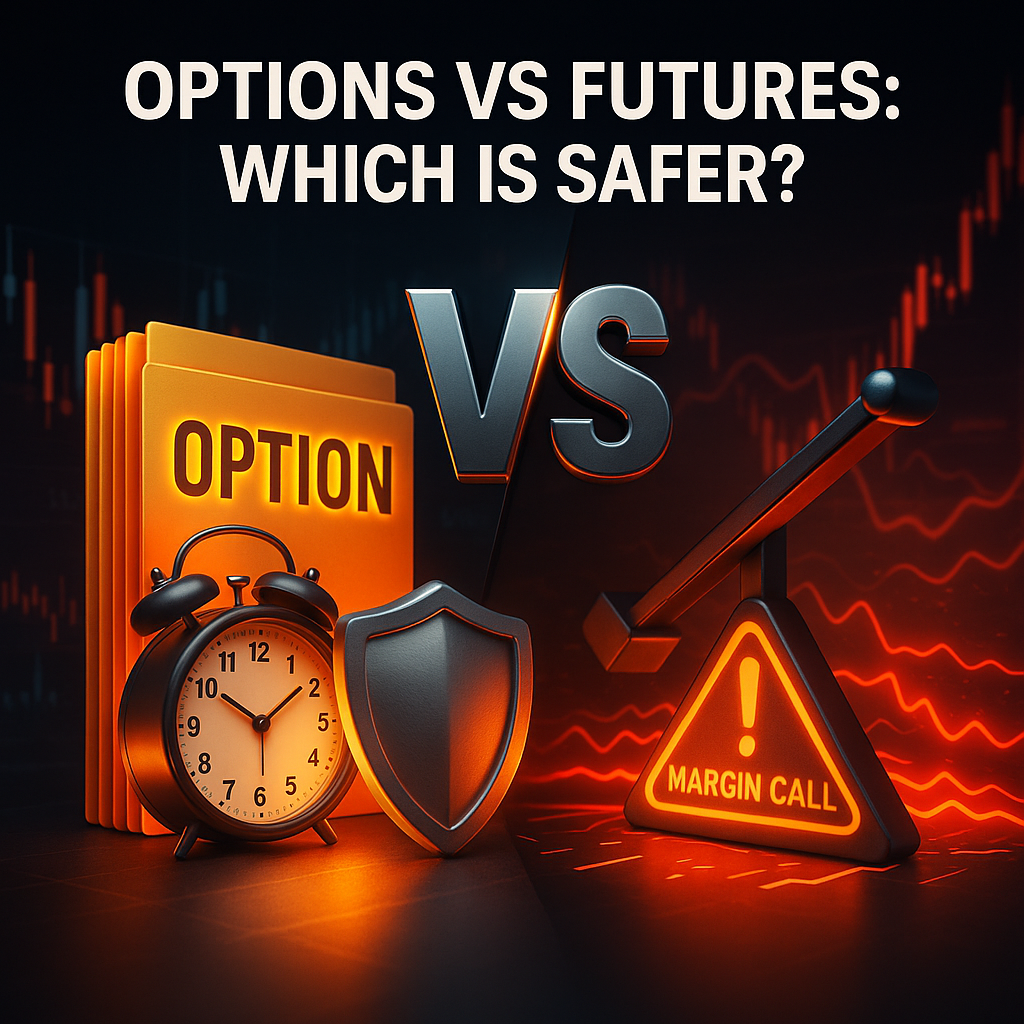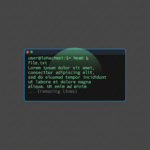Let me start by ruining the suspense: Asking if options are safer than futures is like asking if getting punched in the face is safer than getting kicked in the balls. They’re both going to hurt, just in different ways. I’ve lost money in both, made money in both, and nearly had heart attacks trading both.
But here’s what nobody tells you – the word “safer” in trading is bullshit. Nothing about betting money on future price movements is safe. Your savings account is safe. Your government bonds are safe (mostly). Options and futures? They’re weapons of financial destruction that can either build wealth or destroy it, depending on if you know what the fuck you’re doing.
I’ve traded both for 8 years. Lost $67,000 learning futures the hard way. Lost $43,000 learning options the expensive way. Now I make money with both. Let me tell you the actual difference, the real risks, and which one is more likely to blow up your account (spoiler: it’s probably not the one you think).
The Fundamental Difference (What You’re Actually Trading)
Options: The Right But Not Obligation
When you buy an option, you’re buying the right to do something, but you don’t have to do it. It’s like putting down a deposit on a house – you can walk away and lose your deposit, but you can’t lose more than that.
What This Actually Means:

- Maximum loss is defined (premium paid)
- Can’t lose more than you invested
- Time decay is guaranteed enemy
- Complexity is through the roof
- 85% expire worthless
Real Example:
Buy AAPL $200 call for $500
- Best case: AAPL goes to $220, make $1,500
- Worst case: AAPL stays below $200, lose $500
- Can’t lose more than $500 no matter what
Futures: The Obligation to Deliver
When you trade futures, you’re agreeing to buy or sell something at a specific price on a specific date. It’s like signing a contract to buy a house – you’re committed whether you like it or not.
What This Actually Means:
- No maximum loss (theoretically infinite)
- Leverage is massive (5-20x typical)
- No time decay working against you
- Simpler to understand
- Can blow past your account balance
Real Example:
Buy 1 ES (S&P 500) futures contract at 4,500
- Controls $225,000 worth of S&P 500
- Margin requirement: $12,000
- Every 1 point move = $50 gain/loss
- 100 point move against you = $5,000 loss
The Leverage Difference (Where Shit Gets Real)
Options Leverage: Choose Your Own Adventure
Buying Options:
- Leverage depends on strike/expiration
- Can be 5x to 100x
- But maximum loss is premium paid
- Leverage decreases as option moves against you
Selling Options:
- Leverage can be infinite (naked options)
- Margin requirements vary
- Can lose multiples of premium collected
- This is where options get dangerous
Example of Options Leverage Gone Wrong:
- Sell naked TSLA calls for $1,000 premium
- TSLA announces something crazy
- Stock jumps 30%
- You owe $15,000
- Account blown
Futures Leverage: Always Turned to 11
Standard Futures Leverage:
- ES (S&P 500): 18x leverage
- NQ (Nasdaq): 20x leverage
- CL (Crude Oil): 15x leverage
- GC (Gold): 10x leverage
What This Means:
- 5% move = 90% of account
- 10% move = blown account
- No choice in leverage amount
- Always max leverage
Example of Futures Leverage Disaster:
March 2020 COVID crash
- Long 2 ES contracts
- Account: $30,000
- S&P drops 7% in one day
- Loss: $31,500
- Account: Negative $1,500
- Owe broker money
The Risk Profiles (How Each Can Kill You)
How Options Kill Accounts
Death by Theta (Time Decay):
- Buy option for $1,000
- Stock doesn’t move
- Option decays $50/day
- Three weeks later: $0
- Slow, predictable death
Death by Vega (Volatility):
- Buy calls when IV at 50%
- Stock goes up 5% (you’re right!)
- But IV drops to 30%
- Options lose money anyway
- Confused, painful death
Death by Assignment:
- Sell put spreads
- Get assigned on short put
- Don’t have money to cover
- Forced liquidation
- Surprise death
Death by Complexity:
- Don’t understand Greeks
- Trade complex strategies
- Something unexpected happens
- Lose money, don’t know why
- Ignorant death
How Futures Kill Accounts
Death by Gap:
- Long crude oil futures
- Weekend gap down 10%
- Monday open: Down $4,000 per contract
- No stop loss helped
- Instant death
Death by Leverage:
- Trading 5 ES contracts
- Account: $50,000
- 4% move against you
- Loss: $45,000
- Mathematical death
Death by Overnight:
- Day trade futures successfully
- Forget to close position
- Overnight limit move
- Wake up to margin call
- Sleepy death
Death by Flash Crash:
- May 6, 2010 flash crash
- ES drops 100 points in minutes
- $5,000 loss per contract
- Stops don’t fill
- Technical death
Real Trading Scenarios (My Actual Trades)
Options Trade Example: The Good
April 2024 – NVDA Calls
- NVDA at $850
- Buy 10 May $900 calls at $15
- Cost: $15,000
- Risk: $15,000 (defined)
- NVDA runs to $950
- Sell calls at $52
- Profit: $37,000
- Return: 247%
Why This Worked:
- Defined risk
- Couldn’t lose more than $15,000
- High reward potential
- Time was sufficient
Options Trade Example: The Bad
June 2024 – SPY Put Spreads
- Sell 50 SPY 440/435 put spreads
- Collect $100 per spread
- Total credit: $5,000
- SPY drops to $430
- Max loss hit
- Loss: $20,000
- Return: -400%
What Went Wrong:
- Undefined risk relative to credit
- Too many contracts
- No stop loss
- Held through expiration
Futures Trade Example: The Good
September 2024 – ES Long
- Buy 1 ES at 4,400
- Stop at 4,380
- Target 4,450
- Hits target in 3 days
- Profit: $2,500
- Risk: $1,000
- Clean execution
Why This Worked:
- Clear stop loss
- Proper position sizing
- Respected risk management
- No overnight holds
Futures Trade Example: The Ugly
November 2023 – Crude Oil Disaster
- Long 3 CL contracts at $85
- No stop (genius move)
- OPEC announces production increase
- Oil drops to $78 overnight
- Loss: $21,000
- Account devastated
What Went Wrong:
- Too much leverage
- No stop loss
- Held overnight
- News risk ignored
The Capital Requirements (Real Numbers)
Options Capital Needs
Minimum to Start:
- Can start with $500
- Buy far OTM options
- Usually lose it all
- But can’t lose more
Realistic Minimum:
- $5,000 for basic strategies
- $10,000 for spreads
- $25,000 for day trading
- $50,000+ for selling options
Professional Level:
- $100,000+ for portfolio margin
- Can sell naked options
- Run multiple strategies
- Generate consistent income
Futures Capital Needs
Absolute Minimum:
- $5,000 for micro futures
- $15,000 for mini futures
- One bad day = gone
- Not recommended
Realistic Minimum:
- $25,000 for 1 ES contract
- $50,000 for proper risk management
- $100,000 to trade multiple markets
- $250,000+ for professional trading
The Hidden Cost:
- Futures require more capital reserves
- Need to survive gap moves
- Margin calls at worst times
- Psychological capital enormous
The Complexity Comparison
Options Complexity Level: PhD in Mathematics
What You Need to Understand:
- Greeks (Delta, Gamma, Theta, Vega, Rho)
- Implied vs Historical Volatility
- Volatility Skew
- Term Structure
- Assignment Risk
- Pin Risk
- Early Exercise
- Dividend Risk
- Complex strategies (Iron Condors, Butterflies, etc.)
Learning Curve:
- 6 months to understand basics
- 1 year to be dangerous
- 2 years to be competent
- 5 years to be good
- Never stop learning
Futures Complexity Level: High School Algebra
What You Need to Understand:
- Contract specifications
- Margin requirements
- Rollover dates
- Market hours
- Basic technical analysis
- That’s pretty much it
Learning Curve:
- 1 month to understand basics
- 3 months to be dangerous
- 6 months to be competent
- 1 year to be good
- Mastery in 2-3 years
The Time Decay Factor (The Silent Killer)
Options: Time is Your Enemy (Usually)
As a Buyer:
- Lose money every day from theta
- Weekends cost you money
- Holidays cost you money
- Need to be right AND quick
Theta Decay Reality:
- 45 days out: -$10/day
- 30 days out: -$20/day
- 14 days out: -$40/day
- 7 days out: -$80/day
- Day of expiration: -$200+/day
Futures: Time is Neutral
No Time Decay:
- Can hold position indefinitely
- Only pay rollover costs
- No theta working against you
- Patient traders rewarded
But Carrying Costs:
- Interest on margin
- Rollover fees
- Contango/backwardation
- Still costs, just different
The Emotional Toll (What Nobody Talks About)
Options Emotional Warfare
The Slow Bleed:
- Watch option decay daily
- Hope for movement
- Anxiety builds
- Desperation at expiration
- Depression when expires worthless
The Complexity Stress:
- Did I calculate right?
- What’s my actual risk?
- Why did I lose when I was right?
- Constant second-guessing
The FOMO Factor:
- See 1000% gains posted
- Try to replicate
- Usually fail
- Emotional destruction
Futures Emotional Terrorism
The Leverage Anxiety:
- Every tick matters
- Can’t look away
- $50 moves per point
- Heart rate matches price action
The Gap Terror:
- Weekend positions
- Sunday night opens
- Overnight news
- Wake up to disaster
The Speed Violence:
- Losses accumulate fast
- No time to think
- Panic decisions
- Instant regret
The Practical Comparison (Side by Side)
Buying Options vs Trading Futures
| Factor | Options | Futures |
|---|---|---|
| Max Loss | Premium paid | Unlimited |
| Leverage | Variable (5-100x) | Fixed (10-20x) |
| Time Decay | Yes (killer) | No |
| Complexity | Very High | Moderate |
| Capital Needed | $1,000+ | $15,000+ |
| Assignment Risk | Yes | Always delivered |
| 24/7 Trading | No | Yes (most) |
| Gap Risk | Limited | Unlimited |
| Stress Level | High | Extreme |
Selling Options vs Trading Futures
| Factor | Selling Options | Futures |
|---|---|---|
| Max Loss | Unlimited (naked) | Unlimited |
| Income Generation | Yes | No |
| Time Decay | Friend | Neutral |
| Margin Required | High | Moderate |
| Complexity | Extreme | Moderate |
| Management Needed | Constant | Stop/Target |
Which is Actually “Safer”? (The Nuanced Answer)
Options Are Safer If:
You’re Buying Options:
- Defined maximum loss
- Can’t lose more than premium
- Better for small accounts
- Sleep better at night
You Understand the Greeks:
- Can manage risk properly
- Know what you’re getting into
- Can calculate exact risk
You Have Patience:
- Can wait for setups
- Don’t need constant action
- Can handle slow decay
Futures Are Safer If:
You Have Proper Capital:
- Can handle drawdowns
- Not overleveraged
- Have emergency reserves
You Use Strict Stops:
- Disciplined risk management
- Never move stops
- Accept losses quickly
You Avoid Overnight:
- Day trading only
- No gap risk
- Clean slate daily
My Personal Approach (What I Actually Trade)
After losing money both ways, here’s what I do now:
Options Strategy (60% of Trading)
Selling Premium:
- Iron Condors on SPX
- Credit spreads on earnings
- Covered calls on holdings
- Cash-secured puts
- Monthly income focus
Why: Consistent income, defined risk, time decay advantage
Futures Strategy (40% of Trading)
Day Trading Only:
- ES and NQ only
- 1-2 contracts max
- Clear stops always
- Never hold overnight
- Quick scalps
Why: No overnight risk, clean leverage, simple execution
The Hybrid Advantage
Use Options For:
- Income generation
- Defined risk trades
- Hedging positions
- Longer-term plays
Use Futures For:
- Intraday movements
- Quick directional trades
- News reactions
- Clean leverage
Common Myths Debunked
Myth: “Options Are Always Safer”
Reality: Selling naked options can blow up your account faster than futures
Myth: “Futures Are for Professionals Only”
Reality: Micro futures make them accessible to everyone
Myth: “Options Lose Money From Time Decay”
Reality: Only if you’re buying; sellers profit from decay
Myth: “Futures Are Too Leveraged”
Reality: You control position size; one micro ES = $5 per point
Myth: “Options Are Too Complex”
Reality: Basic strategies are simple; complexity is optional
The Blow-Up Stories (Learn From My Pain)
Options Blow-Up: The Naked Call Disaster
The Setup:
- Sold naked TSLA calls
- Collected $5,000 premium
- “TSLA can’t go higher”
The Disaster:
- Elon announces something
- TSLA gaps up 20%
- Loss: $45,000
- Account: Destroyed
Lesson: Naked options = unlimited risk
Futures Blow-Up: The Overnight Hold
The Setup:
- Long 5 CL contracts
- Up $3,000 for day
- “I’ll hold overnight”
The Disaster:
- China data disappoints
- Oil gaps down 8%
- Loss: $28,000
- Margin call at 3 AM
Lesson: Overnight futures = gap risk
The Bottom Line: Which Should You Trade?
Start With Options If:
- You have less than $10,000
- You want defined risk
- You can handle complexity
- You’re patient
- You want to sell premium
Start With Futures If:
- You have $25,000+
- You want simplicity
- You can follow strict stops
- You day trade only
- You like fast action
The Real Answer:
Neither is inherently safer. It’s like asking if a chainsaw is safer than an axe. Both can cut down trees. Both can cut off your leg. The safety comes from:
- Knowledge – Understanding exactly what you’re trading
- Capital – Having enough to survive mistakes
- Discipline – Following rules without exception
- Risk Management – Never risking more than you can afford
- Experience – Learning from small mistakes before big ones
My Advice After 8 Years
For Beginners:
Start with buying options. Yes, you’ll probably lose money, but you can’t lose more than you put in. Think of it as tuition. Once you understand options, learn futures with micro contracts.
For Intermediate:
Combine both. Use options for directional plays and income. Use futures for day trading. Each tool has its place.
For Advanced:
You already know what works for you. But remember: The market doesn’t care how experienced you are. One moment of arrogance and you’re back to zero.
The Universal Truth:
The safest trade is the one you understand completely. The most dangerous trade is the one you think you understand but don’t.
Options aren’t safer than futures. Futures aren’t safer than options. Knowledge, discipline, and risk management are what keep you safe. Everything else is just leverage wrapped in different packages.
Choose your weapon based on your goals, capital, and temperament. But remember: In trading, the only real safety is in position sizing and stop losses. Everything else is just varying degrees of danger.
And if someone tells you either options or futures are “safe investments,” run. They’re either lying or stupid, and both will cost you money.






